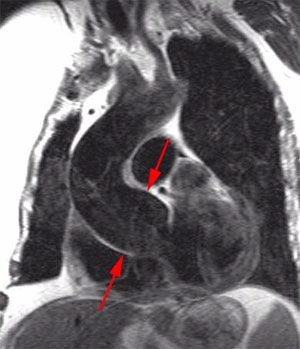The 2006 ACC/AHA valvular heart disease guidelines on the management of an ascending aneurysm associated with a bicuspid aortic valve (BAV) recommend aortic surgery as a class I indication if the aortic diameter reaches 5 cm or if the rate of progression of dilatation is 0.5 cm/yr, irrespective of the health of the aortic valve. The recommendation is based on the belief that BAV is associated with some form of vasculopathy, similar to Marfan’s disease, and imparts a ‘high’ risk of dissection and severe complications.
An editorial in the July 1 issue of the American Journal of Cardiology offers a daring challenge to the proposed dogma.
In his critical review, Warren Guntheroth from the University of Washington makes the cogent point that the guideline recommendations are offered despite scant data on the natural history of this entity.He also states that there is little data to support the presence of a genetic vasculopathy in BAV, and that there could be alternative explanations for the common finding of ascending aortic dilatation in those patients.He finally brings up the obviously important point that surgical decision is problematic if the valve is reasonably functional at the time of the elective operation.
In the rebuttal editorial, Robert Bonow, the lead author on the guidelines makes counterpoints that are unconvincing or even specious. Besides listing a number of studies that have no bearing on Guntheroth’s argument, he denies that the guidelines cite cystic medial necrosis as playing a role in the aneurysm formation (a point of view criticized by Guntheroth). However, the only histopathological reference listed in the guidelines to illustrate the vasculopathy theory does in fact conflate CMN, Marfan’s aortic disease and the aortic dilatation associated with BAV.
Bonow also criticizes Guntheroth for using the term “post-stenotic dilatation” but mischaracterizes his opponent’s understanding of the relationship between aortic dilatation and stenosis. Nowhere in his essay does Guntheroth suggest that the dilatation is due to the stenosis. In fact the term is perfectly correct if understood simply as an anatomic relationship.
Additionally, Bonow cites a 2007 retrospective study of the natural history of aortic aneurysm to support the guidelines recommendation. But the study, published after the guidelines were released, actually describes much lower pre-operative mortality and catastrophic events in BAV-associated aneurysms than in the comparative group and would actually oppose the thrust of the guideline recommendation.
Most telling, however, is Bonow’s irritation in the presence of a dissenting opinion:
Dr. Guntheroth is entitled to state his own expert opinion, as he has done. However, he appears to be an “expert” who is out of sync with many other “experts,” including but not limited to those on the ACC/AHA guidelines committee. He has ignored the fact that the same threshold for surgery on the aorta (aortic diameter >50 mm) recommended in the 2006 ACC/AHA guidelines in patients with BAV was also recommended independently by the writing committee of the 2007 guidelines on the management of valvular heart disease of the European Society of Cardiology.
In other words, the consensus of expert ignorance at home and abroad should substitute for the lack of tangible data anywhere.
The influence of guidelines on the behavior of physicians is metastasizing. Medical students and residents read guidelines, or at least invoke them, as one would the Scriptures. They form the stuff of “clinical pathways” and the meat of “pay-for-performance” schemes that turn collegial advice into indisputable mandates. So when guidelines recommend high-risk surgeries for asymptomatic patients with debatable prognosis, are they demanding an act of faith? Praise to Guntheroth for raising the question.
